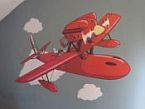juliet7bravo
Posts: 894
Joined: 5/30/2001
Status: offline

|
http://pigtrail.uark.edu/people/rcordell/Defense/minewar.html
"Oropesa Sweep
This is the "O" gear referred to in all of the deck logs of the USS DEFENSE. It consisted of a single wire with a torpedo-shaped float (a paravane) attached to the end. Out near the paravane was a device called an "otter" — consisting of an array of angled fins that pulled down on the end of the sweep and kept it at the proper depth. The length of wire between the paravane and the otter was called the "pendant." There was also a "depressor" up near the ship, suspended on a length of "depressor wire." This was used to pull the end of the sweep wire nearest the ship down to the desired depth. There were also cutters spaced along the sweep wire that would sever the chains holding the mines, allowing them to float to the surface and be shot and exploded by the mine disposal ships."
http://www.warships1.com/
"Similar to other underwater weapons, the Japanese did not spend much energy on mines prior to World War II. This was mainly because mines were considered to be "defensive" weapons and so were not of value to an "offensive" minded Navy.
Almost all Japanese mines were of Hertz Horn construction. No magnetic (influence) mines were developed although a number of British A Mark I - IV mines captured at Singapore were laid off Balikapan in 1945. A shore-controlled mine with an acoustic detector was developed late in 1944 and 144 were laid across the entrance to Tokyo Bay.
Triggering or Fuzes
As mentioned above, the Japanese used Hertz Horns almost exclusively. Each horn contained acid. Contact with the horn broke open the acid container which energized a battery and exploded the mine. During the war a variation was developed that replaced the acid horns with switches that activated when a ship hit the horn. By definition, horned mines were short ranged weapons and fields needed to be densely packed to be effective against shipping."
XXXXXXXXXXXXXXXXXXXXXXX
Perfectly logical for a DD supporting minesweepers to see (and shoot/explode) mines cleared by MSW's. Moored contact mines were what was primarily by the IJN. The MSW's cuts the cable, it floats to the surface, gets missed by the lookouts...the trailing DD sees and shoots (or sometimes eats it) it. Dangerous work, but that's why so many mine warfare ships and mine field tenders were casualties during WW2.
Not unusual either BTW, for ships to see and explode or hit mines whose moorings had broken, especially after storms. Not to mention "drift mines" being used extensively in confined waters.
Incidentally, while I might be mistaken, I seem to recall reading that the "hasty mine fields" the US DMS's were laying in 'The Slot" during the UV/GC time period were composed of Mk7 "Drift Mines".
|
 Printable Version
Printable Version



















 New Messages
New Messages No New Messages
No New Messages Hot Topic w/ New Messages
Hot Topic w/ New Messages Hot Topic w/o New Messages
Hot Topic w/o New Messages Locked w/ New Messages
Locked w/ New Messages Locked w/o New Messages
Locked w/o New Messages Post New Thread
Post New Thread